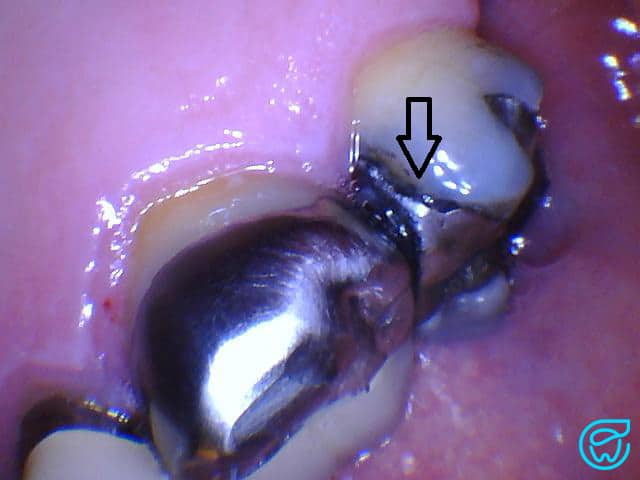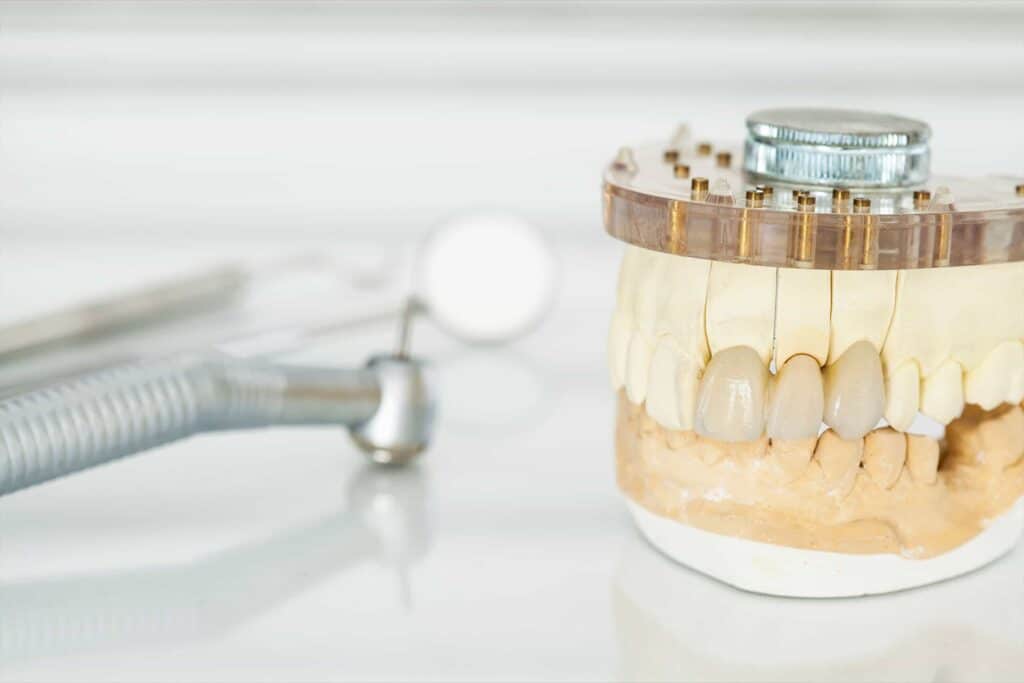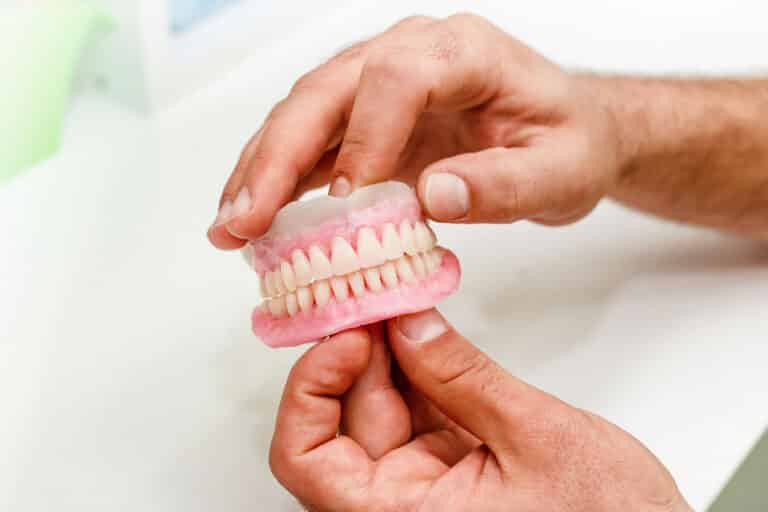Dental crowns are a staple restorative dental treatment with tens of thousands done every week across the country. They are a tried and true treatment that has withstood the test of time to improve the esthetics and function of many people’s teeth. However nothing, including dental crowns, will last forever and will eventually need to be replaced.
While each individual crown has variable lifetimes based on numerous factors, they generally have a lifetime of 10-15 years1https://www.sciencedirect.com/science/article/abs/pii/S0300571218301301,2https://www.sciencedirect.com/science/article/abs/pii/S030057121630166X. There are many dental crowns that last much longer (several decades long) or shorter as well. Due to general wear and tear and hostile environment of the mouth, they will eventually wear out, break, or decay to the point of failure.
There are multiple reasons why they may need to be placed. Several reasons include fracture, dental decay, esthetics, reconstruction, and preemptive protection. The reasons will also slightly vary depending on whether the dental crown is an initial or replacement crown.
Reasons Why a Dental Crown May Need to be Replaced
There are a few reasons why existing dental crowns may need replacing. These are: if the current crown is failing, for advanced prosthetics, or esthetic reasons. By and far the most common reason is the first, since all dental work fails given enough time.
Failing Restoration

A failing dental restorationA synthetic material that replaces either part or the whole tooth that is missing due to disease or trauma. means it has recurrent decay, fracture, or marginal breakdown. The mouth is a hostile environment that is subject to daily pH changes as well as microscopic bacterial invasions. If proper dietary and hygiene practices are not maintained, a new cavity will form at the marginThe interface between a restoration and the tooth. This is the most common area for a cavity to reoccur on a tooth. of the dental crown. This occurs most commonly in between teeth but may occur anywhere where the crown meets the tooth. Once there is new decay, the crown must be replaced to save it. Even if proper hygiene is completed, the crown can still break or wear down to the point of replacement.
Fracture or Wear and Tear
Another reason a dental crown needs to be replaced is because of fracture or wear and tear. Depending on the material, crowns will be more prone to either fracturing or wear. Due to the nature of the material itself, ceramic crowns are more prone to fracture than their gold counterparts.
Gold crowns will be more likely to wear through the occlusalThe ‘top’ of teeth where chewing occurs on posterior teeth. This surface has pits and grooves. surface than a ceramic crown. Fractured crowns can result in food impactionWhen food gets stuck in between teeth. This causes irritation in the gums and can be very uncomfortable. and when the structural integrity is compromised, it should be replaced as it may not be able to protect the underlying tooth as well. If there is a pattern of severe wear and tear as well as fracturing, there may be an underlying cause of pathologic bruxism due to jaw positioning. This can result in temporomandibular joint dysfunctions and may require additional intervention.
Esthetics
Depending on the crown’s age and amount of gum recession that has occurred, the esthetics of dental crowns may be compromised enough to warrant replacement. This is most common for anterior crowns, since they’re in the smile line. Porcelain fused to metal (PFM) crowns are less esthetic than newer style ceramic crowns and are easily singled out as a prosthetic when viewed. This is partially why anterior PFM crowns are not used as commonly as porcelain crowns. While they are not a bad type of crown, other more effective options exist.
Prosthetics
Prosthetically, there are a few reasons why you should replace a dental crown. The first is if there is already a crown on a tooth undergoing bridgework. Even if the existing crown is perfectly functional, it will need to be an abutment tooth to anchor one side of a dental bridge. Since the existing crown cannot be used in the fabrication of a new bridge, it will have to be removed and will then become part of the new bridge.
Although less common, another reason is due to either an excess. When teeth drift, it can result in space between teeth or drifting into a space for an implant or other prosthetic. When this happens, orthodontics can be done to correct the position of the tooth. Alternatively, if the drifted tooth has a crown, sometimes the crown can be removed and redesigned for better function.
It is much less common to replace crowns due to crowding. This is because orthodontic treatment is generally a much better option and they are always made in the best esthetic position, to begin with.
How Often do Crowns Need to be Replaced?
Dental crowns must be replaced whenever they are compromised, typically crowns last 10-15 years. Depending on a multitude of factors, that number will vary. There are some that are still functional after 40-50 years as well as those that have failed after a couple of years.
Common factors that influence the longevity of crowns include:
- Oral hygiene habits
- Diet and frequency of meals
- Trauma
- Occlusal scheme
- Parafunctional habits (e.g. bruxism)
- Misuse (e.g. opening beer bottles with teeth)
- Familial factors
- Staining and compromised esthetics
When well maintained and cleaned, crowns can easily last or exceed the expected 10-15 year lifetime. Recurrent cariesDental caries that reoccurs at the margin of an existing restoration. is an extremely common reason to replace crowns which means at the minimum proper brushing, flossing, and professional dental cleanings are paramount. However there can still be events out of one’s control, such as acute trauma (e.g. falling down), that require replacing crowns.
Can I Repair a Dental Crown Instead or Replacing it?
There are many factors that come into play when considering whether or not a crowned tooth can be repaired or patched, but the short answer is that it is possible in a few circumstances to repair crowns instead of replacing them. If it is possible, the dentist can sneak under the existing crown to remove the dental decay and restore it with a filling material such as compositeA synthetic resin that is used for while fillings. This is what most people receive when they get fillings., glass ionomer or amalgam. However in order to do so, there are certain requirements that must be met in order to be eligible for a crown repair instead of replacing. Those factors include, but are not limited to:
- The reason to repair the crown is due to dental cariesMost commonly known as a tooth cavity, dental caries refers to decay and rot of the tooth. The breakdown of the enamel and/or dentin is caused by oral bacteria leaving acid on the teeth as a by-product of food consumption. Dental caries is referred to by various names including cavities, tooth rot, and decay., not fracture.
- The caries must be in an easily accessible location.
- The caries must not extend subgingivally.
- The caries must be small.
When considering whether or not a crown may be repaired or not, the most important thing that needs to be accomplished is that the tooth is caries free after the procedure. While it may seem obvious that it must not have any disease and is functional once the procedure is done, the previously mentioned factors play a huge role in the predictability of repairing crowns. If the dentist cannot be sure that it can be disease free from a crown repair, then they may recommend replacing instead.
Due to the nature of the material itself, ceramic as opposed to gold, may fracture over time. Since proper adherence of additional materials (e.g. porcelain or glaze) to them uses techniques that require the tooth not be in someone’s mouth (such as firing in an oven), it is very difficult to predictably repair cemented crowns. This is especially true if the patient has a pathologic occlusion that leads to constant fracturing of teeth and crowns.
The dental caries must be easily accessible in order to be repaired or patched. If the dentist cannot achieve quality work and ensure all the disease is removed because of the location, then the crown cannot be repaired.
This is most common when the caries is located interproximally. When the caries is located at either the facialThe ‘outside’ surface of the teeth that directly face either the lips or cheeks. or lingual margin, it may be possible to repair. It is extremely unpredictable to properly remove and repair interproximal decay since proper isolation and access is nearly impossible at this location.
The caries must not extend subgingivally in order to be repaired. This also is an access issue as proper isolation is key to direct restorative work. Moisture will interfere with many restorative processes. While amalgam is less susceptible to moisture, many people prefer to not use amalgam.
The caries must also be small to be repaired. Since the tooth must be free of caries after treatment, the dental caries must be small and not significantly extend under the crown. If the decay extends too far, it becomes difficult to determine if the decay has been completely removed. Additionally, excess removal of the crown structure can compromise the integrity which would necessitate replacing the entire dental crown.
What Should I Expect When Getting Dental Crowns Replaced?
The process of getting a dental crown replaced is almost the same as when there is no pre-existing one. Most of the time the pre-existing dental crowns need to be removed and are typically sectioned off into pieces. There are other techniques to remove dental crowns such as using a crown tapper or crown removing ‘gummy’. While these techniques work well, they can be a bit more unpredictable as they require force to pry off the crown. Once it is removed, the process is the same when first getting the procedure. it is important to maintain good oral hygiene habits in order to extend the life of your crowned tooth.
How Much Does it Cost to Replace a Dental Crown?
The cost to replace a crown is typically the same as first placing a crown. This cost will range very widely on a number of factors but you can expect a range of $500 to $2,000 or even more per crown. You will need to speak to your dentist for more information. If you plan on using insurance, there are several important factors explained below to consider. You may have unexpected out of pocket costs if you don’t pay close attention to these factors.
Does Insurance Cover Crown Replacement?
Insurance will cover crown replacements, if a few factors are met. The most common factors are frequency limitations and remaining benefits.
Frequency limitations refers to how often, in years, your insurance will cover the cost of a crown. The actual number of years an insurance states they will cover replacing crowns will vary.
Generally, plans will cover crowns every 5 to 10 years with every 7 years being very common. This means that if your crown frequency limitation is every 7 years, the insurance will cover replacing the crown every 7 years. If the crown needs to be replaced 3 years after being placed, they will typically not cover it.
Remaining benefits refers to the annual pool of money which goes towards many dental treatments. This benefit ranges from $1,000 – $3,000. If you’ve already used up all your benefits or do not have enough remaining to cover the cost of the crown, then your insurance company will not pay for the crown.
Was this post helpful?
Table of Contents
References
- 1
- 2





